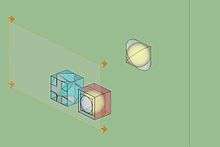Steinmetz solid
In geometry, the Steinmetz solid is the solid body generated by the intersection of two or three cylinders of equal radius at right angles. It is named after Charles Proteus Steinmetz, though these solids were known long before Steinmetz studied them.
If two cylinders are intersected, the overlap is called a bicylinder or mouhefanggai (Chinese for two square umbrellas,[1] written in Chinese as 牟合方蓋). It can be seen topologically as a square hosohedron. If three cylinders are intersected, then the overlap is called a tricylinder.
Bicylinder

Volume
The bicylinder is topologically equivalent to the square hosohedron. Archimedes and Zu Chongzhi calculated the volume of a bicylinder in which both cylinders have radius r. It is

The volume of the two intersecting cylinders can be calculated by subtracting the volume of the overlap (or the bisector in this case) from the volume of the two cylinders added together.
Deriving the volume of a bicylinder (white) can be done by packing it in a cube (red). A plane (parallel with the cylinders' axes) intersecting the bicylinder forms a square and its intersection with the cube is a larger square. The difference between the areas of the two squares is the same as 4 small squares (blue). As the plane moves through the solids, these blue squares describe square pyramids with isosceles faces in the corners of the cube; the pyramids have their apexes at the midpoints of the four cube edges. Moving the plane through the whole bicylinder describes a total of 8 pyramids.

The volume of the cube (red) minus the volume of the eight pyramids (blue) is the volume of the bicylinder (white). The volume of the 8 pyramids is: , and then we can calculate that the bicylinder volume is
Surface area
The surface area is 16r2. The ratio of between surface area and volume holds more generally for a large family of shapes circumscribed around a sphere, including spheres themselves, cylinders, cubes, and both types of Steinmetz solid (Apostol and Mnatsakanian 2006).
The surface of the bicylinder consists of four cylindrical patches, separated by four curves each of which is half of an ellipse. The four patches and four separating curves all meet at two opposite vertices.
Derived solids
A bisected bicylinder is called a vault,[2] and a cloister vault in architecture has this shape.
Tricylinder

The tricylinder has fourteen vertices connected by elliptical arcs in a pattern combinatorially equivalent to the rhombic dodecahedron. Its volume is
and its surface area is
More cylinders
With four cylinders, with axes connecting the vertices of a tetrahedron to the corresponding points on the other side of the solid, the volume is
With six cylinders, with axes parallel to the diagonals of the faces of a cube, the volume is:
References
- ↑ http://thesaurus.maths.org/mmkb/entry.html?action=entryByConcept&id=3736
- ↑ Weisstein, Eric W. (c. 1999–2009). "Steinmetz Solid". MathWorld—A Wolfram Web Resource. Wolfram Research, Inc. Retrieved 2009-06-09. Check date values in:
|date=(help)
Bibliography
- Apostol, Tom M.; Mnatsakanian, Mamikon A. (2006). "Solids circumscribing spheres" (PDF). American Mathematical Monthly. 113 (6): 521–540. JSTOR 27641977. MR 2231137. doi:10.2307/27641977.
- Hogendijk, Jan P. (2002). "The surface area of the bicylinder and Archimedes' Method". Historia Math. 29 (2): 199–203. MR 1896975. doi:10.1006/hmat.2002.2349.
- Moore, M. (1974). "Symmetrical intersections of right circular cylinders". The Mathematical Gazette. 58 (405): 181–185. JSTOR 3615957. doi:10.2307/3615957.
External links
- A 3D model of Steinmetz solid in Google 3D Warehouse
- Weisstein, Eric W. "Steinmetz Solid". MathWorld.
- Intersecting cylinders (Paul Bourke, 2003)
- (ASU student)